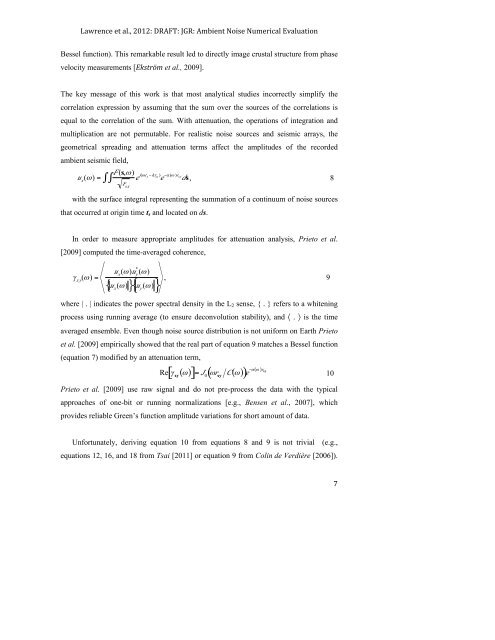Lawrence et al., 2012: DRAFT: JGR: Ambient Noise Numerical ...
Lawrence et al., 2012: DRAFT: JGR: Ambient Noise Numerical ...
Lawrence et al., 2012: DRAFT: JGR: Ambient Noise Numerical ...
You also want an ePaper? Increase the reach of your titles
YUMPU automatically turns print PDFs into web optimized ePapers that Google loves.
<strong>Lawrence</strong> <strong>et</strong> <strong>al</strong>., <strong>2012</strong>: <strong>DRAFT</strong>: <strong>JGR</strong>: <strong>Ambient</strong> <strong>Noise</strong> Numeric<strong>al</strong> Ev<strong>al</strong>uation<br />
Bessel function). This remarkable result led to directly image crust<strong>al</strong> structure from phase<br />
velocity measurements [Ekström <strong>et</strong> <strong>al</strong>., 2009].<br />
The key message of this work is that most an<strong>al</strong>ytic<strong>al</strong> studies incorrectly simplify the<br />
correlation expression by assuming that the sum over the sources of the correlations is<br />
equ<strong>al</strong> to the correlation of the sum. With attenuation, the operations of integration and<br />
multiplication are not permutable. For re<strong>al</strong>istic noise sources and seismic arrays, the<br />
geom<strong>et</strong>ric<strong>al</strong> spreading and attenuation terms affect the amplitudes of the recorded<br />
ambient seismic field,<br />
, 8<br />
with the surface integr<strong>al</strong> representing the summation of a continuum of noise sources<br />
that occurred at origin time ts and located on ds.<br />
In order to measure appropriate amplitudes for attenuation an<strong>al</strong>ysis, Pri<strong>et</strong>o <strong>et</strong> <strong>al</strong>.<br />
[2009] computed the time-averaged coherence,<br />
, 9<br />
where | . | indicates the power spectr<strong>al</strong> density in the L2 sense, { . } refers to a whitening<br />
process using running average (to ensure deconvolution stability), and 〈 . 〉 is the time<br />
averaged ensemble. Even though noise source distribution is not uniform on Earth Pri<strong>et</strong>o<br />
<strong>et</strong> <strong>al</strong>. [2009] empiric<strong>al</strong>ly showed that the re<strong>al</strong> part of equation 9 matches a Bessel function<br />
(equation 7) modified by an attenuation term,<br />
Pri<strong>et</strong>o <strong>et</strong> <strong>al</strong>. [2009] use raw sign<strong>al</strong> and do not pre-process the data with the typic<strong>al</strong><br />
approaches of one-bit or running norm<strong>al</strong>izations [e.g., Bensen <strong>et</strong> <strong>al</strong>., 2007], which<br />
provides reliable Green’s function amplitude variations for short amount of data.<br />
Unfortunately, deriving equation 10 from equations 8 and 9 is not trivi<strong>al</strong> (e.g.,<br />
equations 12, 16, and 18 from Tsai [2011] or equation 9 from Colin de Verdière [2006]).<br />
10<br />
7
















